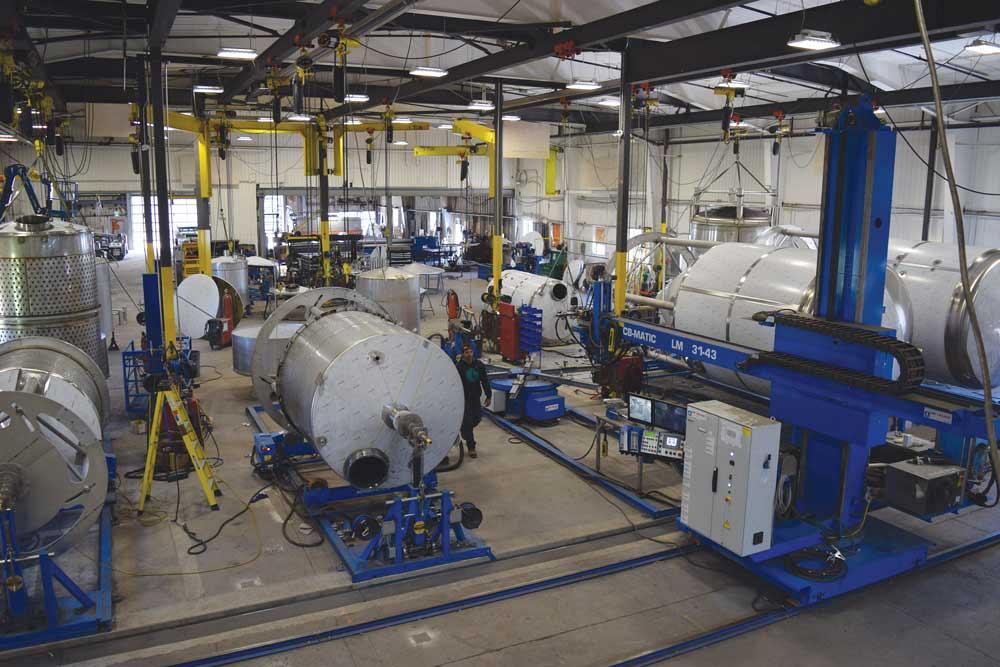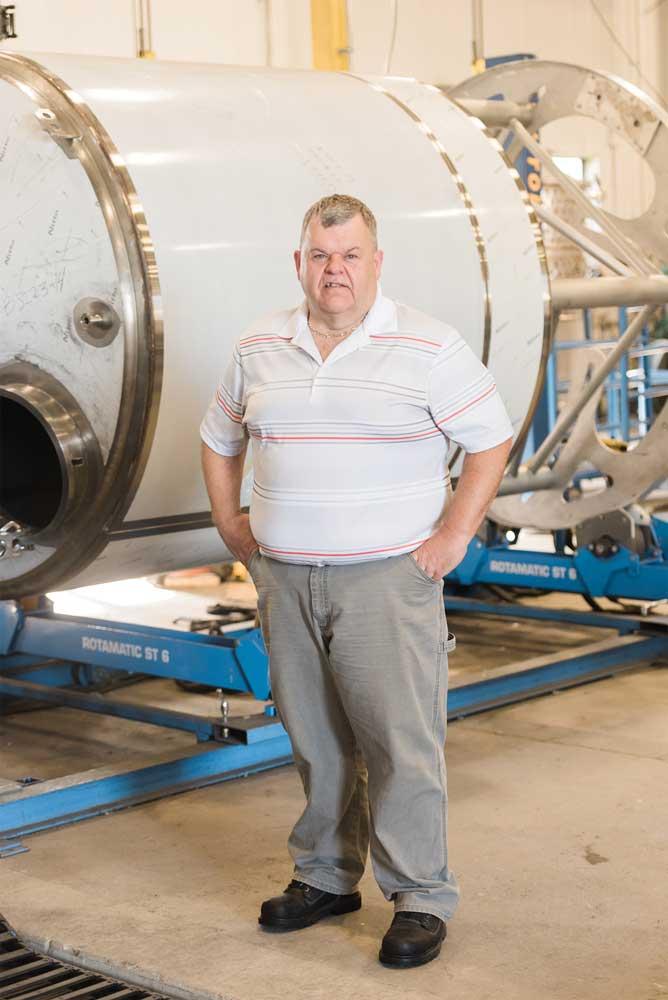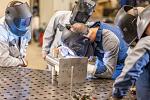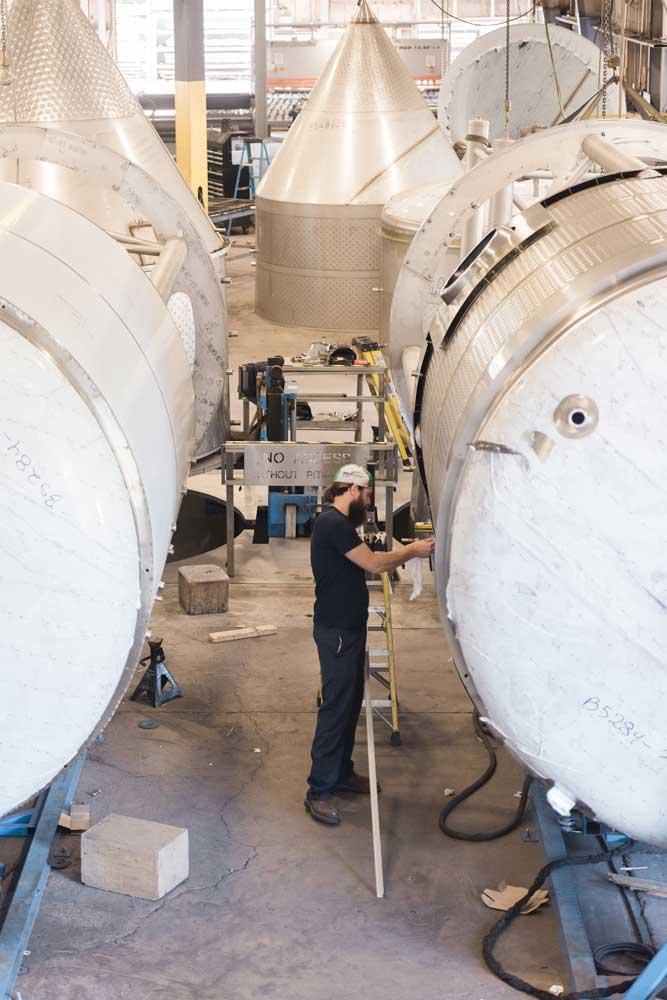Editor
- FMA
- The Fabricator
- FABTECH
- Canadian Metalworking
Better brewing through automation
PEI’s DME Group ups production through streamlining of fabrication processes
- By Rob Colman
- August 15, 2018
- Article
- Automation and Software

For some larger vessels that require more intricate welding by hand before the seams are welded on the CB-Matic, the shop has a platform that can be lowered 8 feet into the ground. This allows the fabricators welding the vessel to work without use of ladders, making the job safer and faster. Here we see a team preparing to weld a platform onto the bottom of a vessel in one of the pits. Photos by Rachel Peters / Volume 18.
During the recent Moncton MMP Expo, the keynote speaker, economist David Campbell, noted that one of the bright spots for manufacturing in the Maritimes currently is Prince Edward Island. One of the companies that is helping to make the province so successful is DME Group, which made its name fabricating brewhouse equipment that it ships around the world.
DME has been in business for 27 years now, and although brewhouse equipment is its bread and butter, it also serves the custom fabricating needs of the biotech, industrial, and food sectors. DME stands for Diversified Metal Engineering, so it’s no mistake that the company touches so many industries. Because of the work involved in designing and assembling brewery equipment, the company has the engineering and fabricating expertise for work involving vessels, piping, controls, and automation, so serving these complementary sectors just makes sense.
The challenge for any company in a small market is training and keeping talent. This is where the founder and president/CEO of the company Peter Toombs has made considerable investments. He understands that it’s the people who are going to make sustainable success in PEI a reality. That team’s input has been key in the company’s push toward greater automation as well.
Staff Incentives and Education
Part of maturing as a company is changing your manufacturing processes to suit a larger team. What worked for a small group of friends 27 years ago can’t work in a shop of 115 fabricators in DME’s PEI facilities alone.
“It used to be that you’d take a blueprint, a welder, and a fabricator, put them in a corner and they’d build a tank,” said Director of Manufacturing Blair MacKinnon. “For years we had teams that had their own workstations. But we came to recognize that, doing things that way, we couldn’t keep up with the work and maintain quality at the necessary level.”
The owner did create incentives for his fabricators to boost both morale and the speed of delivery. For instance, he created an employee tool-purchasing program, by which the company covered 50 per cent of the cost of an employee’s kit of tools.
“This was so employees could buy their own polishing and grinding tools, which can be very expensive,” said MacKinnon. “DME would buy the tools up front, and the employee had two years to pay 50 per cent of it back. After two years the employee owned the tools, and DME looked after the maintenance.” In a way, being able to own their own tools gave employees a sense of ownership in the work.
The company also created an incentive program to encourage speedier completion of jobs.
“The project bonus system involved having a target time in which to finish certain projects,” said MacKinnon. “It allowed employees to do very well by beating those targets. It also encouraged them to discuss potential design changes with our engineers to speed up the processing times. So not only did it benefit employees financially, it benefited our processes long term.”

The biggest automation investment DME made was in a CB-Matic LM 31 by 43 column and boom welder for vessel welding from Air Liquide. It is capable of welding on the horizontal or vertical. In the DME shop, it sits on a track that allows it to be moved to any one of five stations on which tanks can be turned to allow a full seam to be completed around a vessel quickly and cleanly.
Inevitably production has become more streamlined over time, meaning that senior fabricators now are called on to manage more complex work. However, DME wants its employees to have the opportunity to push themselves and rise in the ranks, so they’ve set up their own training program.
“We set up job classifications for our fabricators so that they know precisely what skills they need to move into each higher position in our facility,” said MacKinnon. “If you want a certain pay raise you have to be able to do a certain set of skills. With support from Skills PEI, a team of lead fabricators created online video training sessions filmed on our shop floor to help employees understand different processes.”
DME’s training program was critical to ensure it could get the skills it needed for the specific job at hand.
“We found that welders coming out of school knew how to weld, but they weren’t necessarily ready to build brewhouse vessels,” said Whitney Hooper, director of marketing and communications. “The videos and other training tools walk them through the fundamental building blocks of this industry.”
DME also works closely with Holland College, the Island’s primary technical college, to identify promising gas tungsten arc welding (GTAW) welders within their welding program. In 2015, DME created the Ninja Award, which recognizes two rising stars in the welding field in their second year of the program. The organization also brings in a group from the college for on-the-job training each year, so welders in training can get exposure to the brewing industry.
These efforts not only make it possible for the company to keep production efficient, it also simplifies efforts to achieve and maintain CRN, ASME, and ISO:9001 certifications. A knowledgeable team makes all other projects run more smoothly.
Automation Gains
All of this has been particularly important to the company in the past five years as the microbrewery industry here in North America and around the world has grown in leaps and bounds. Two years ago, DME acquired Abbotsford, B.C.-based Newlands Systems, a similarly sized brewhouse manufacturer. Between the two companies, their systems have been shipped to 67 different countries for use in around 1,600 projects to date. DME now has satellite manufacturing facilities for storage tank fabrication in South Carolina and manufacturing partners in India and China as well.
However, most of the primary fabrication of the specialized brewhouse vessels still needs to be completed in Charlottetown and Abbotsford, and in the past few years space has been tight for the company in its Charlottetown location. Luckily, two years ago DME bought yet another company, Atlantic Systems Manufacturing Ltd., a designer and fabricator of custom food processing and handling equipment. Its shop was directly across the street, so DME decided to shift ASM’s production and expand its brewery equipment manufacturing footprint to include this space. Late last year the company completed the necessary production shifts into this facility without ever having to disrupt production in the old facility.
“In the new building the stainless steel is cut on our waterjet, it is rolled, the flat seams, base, and tops are welded, the inner and outer shells are welded, and the tank’s insulation is installed,” said Hooper. All welding in the shop is GTAW. “In our original facility, all of the specialized internal work is completed – the installation of pipes, false bottoms, rakes, motors, etc. Our shipping bay is in the older facility as well, so there is a smooth flow of components from raw material to finished product from one building to the next.”
The more streamlined design of the shop floor was important to increase productivity, but the shop also required new equipment to meet sales forecasts.
“We couldn’t get to the numbers our sales team was forecasting even if we built a building twice that size without making production more like a car assembly line and adding some automation,” said MacKinnon.
DME started the process of designing this new facility two years ago and included its top 12 fabricators in the discussion to ensure that their plans would work.
“We’ve always referred to our team as ‘the DME family,’” said MacKinnon. “Our owner is the first person to say that we’re in the people business. He has always encouraged feedback and open dialogue. Of course, that’s always backed up with sound reporting mechanisms in the back that tell you how you’re doing.”
The biggest automation investment DME made was in a CB-Matic LM 31 by 43 column and boom welder for vessel welding from Air Liquide. It is capable of welding on the horizontal or vertical. In the DME shop, it sits on a track that allows it to be moved to any one of five stations on which tanks can be turned to allow a full seam to be completed around a vessel quickly and cleanly.
“GTAW is a process that is time-consuming and requires precision from welders,” said MacKinnon. “Finding enough skilled welders to maintain our productivity and quality levels with the speed that it required of high-volume production is difficult to do in any market.”
For some larger vessels that require more intricate welding by hand before the seams are welded on the CB-Matic, the shop has a platform that can be lowered 8 feet into the ground. This allows the fabricators welding the vessel to work without use of ladders, making the job safer and faster.
The installation of a number of cranes throughout this facility also has added an element of safety to the movement of each tank.
The legs and any hatches required also are installed in this facility. Once all this work is done, the tanks are ready to move across the street for the completion of the detail work.
DME has gained a 25 per cent increase in manufacturing efficiency to date from this investment, which it expects to see increase further as it continues to unlock new capabilities on the equipment.

“We’ve always referred to our team as ‘the DME family,’” said Director of Manufacturing Blair MacKinnon. “Our owner is the first person to say that we’re in the people business. He has always encouraged feedback and open dialogue. Of course, that’s always backed up with sound reporting mechanisms in the back that tell you how you’re doing.”
This is just the start of DME’s journey toward greater automation. MacKinnon wasn’t specific about plans but did explain that the company is working on more than just equipment.
“For instance, we do a little 5S work for lean management of the shop, but we’re not where we want to be in that respect,” MacKinnon explained. “We also barcode all of our parts so that we can report progress back to our management system at every stage of a project. This is useful because every project is budgeted for both labour and materials, so we can track that efficiently. But we have plans to update our factory scheduling system and are just in the early stages of making that a reality. The largest oversight I made was believing it would be easy to make sure that each part would be at the right station at the right time. Finding out how challenging that was an eye-opener for me. We are currently training our supervisors on an upgraded reporting system to make sure they are comfortable with it before we take it any further.”
This regular consultation with staff about operational changes and upgrades is something of an extension of the problem-solving nature of the business itself. After all, each client has challenges of its own with respect to the building in which it is installing the equipment.
“We see various challenges, whether it be the requirements of a heritage property, height issues, or installation difficulties,” said Hooper. “That’s what I’d consider one of our competitive advantages. With 27 years in the business, we’ve seen ups and downs, and we’ve seen pretty much every issue you could throw our way. We can use that knowledge to help our customers build their business. From sales to project managers and engineers, we support a client through every step of the process.”
Editor Robert Colman can be reached at rcolman@canadianfabweld.com.
DME Group, www.dmebrewing.com
About the Author

Rob Colman
1154 Warden Avenue
Toronto, M1R 0A1 Canada
905-235-0471
Robert Colman has worked as a writer and editor for more than 25 years, covering the needs of a variety of trades. He has been dedicated to the metalworking industry for the past 13 years, serving as editor for Metalworking Production & Purchasing (MP&P) and, since January 2016, the editor of Canadian Fabricating & Welding. He graduated with a B.A. degree from McGill University and a Master’s degree from UBC.
subscribe now


Keep up to date with the latest news, events, and technology for all things metal from our pair of monthly magazines written specifically for Canadian manufacturers!
Start Your Free Subscription- Trending Articles
Class is in session for college connections

BlueForge Alliance partners with Nuts, Bolts & Thingamajigs to develop Submarine Manufacturing Camps

Engine-driven welding machines include integrated air compressors

Orbital tube welding webinar to be held April 23

Portable system becomes hot tech in heat treatment

- Industry Events
ZEISS Quality Innovation Days 2024
- April 15 - 19, 2024
Tube 2024
- April 15 - 19, 2024
- Düsseldorf, Germany
CTMA Economic Uncertainty: Helping You Navigate Windsor Seminar
- April 30, 2024
- Windsor, ON Canada
MME Winnipeg
- April 30, 2024
- Winnipeg, ON Canada
CTMA Economic Uncertainty: Helping You Navigate Kitchener Seminar
- May 2, 2024
- Kitchener, ON Canada

















